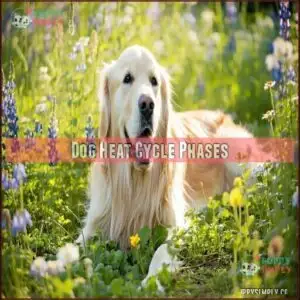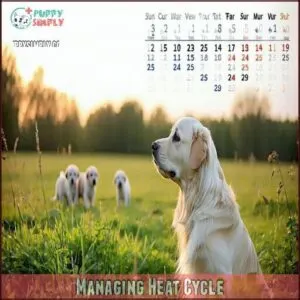This site is supported by our readers. We may earn a commission, at no cost to you, if you purchase through links.
 When you’re wondering how long a female dog stays in heat, you’ll typically see the cycle lasting 2-4 weeks.
When you’re wondering how long a female dog stays in heat, you’ll typically see the cycle lasting 2-4 weeks.
Most dogs experience heat twice a year, though this can vary by breed and individual.
During this time, you’ll notice physical and behavioral changes, including swelling and discharge. Your pup might seem more restless or attract male dogs’ attention.
The heat cycle isn’t just about reproduction—it’s a complex hormonal process that can impact your dog’s mood and behavior. While every dog is different, understanding her cycle helps you provide better care and support during this natural biological phase.
Table Of Contents
- Key Takeaways
- Female Dog Heat Cycle
- How Long in Heat
- Dog Heat Cycle Phases
- Signs of Heat Cycle
- Heat Cycle Frequency
- Health Risks and Complications
- Managing Heat Cycle
- Caring for Dog in Heat
- Heat Cycle and Aging
- Long-Term Heat Cycle Management
- Frequently Asked Questions (FAQs)
- How long does a dog’s heat cycle last?
- How long does a female dog stay in heat?
- What is a female dog’s heat cycle?
- How long do small breed dogs stay in heat?
- When do dogs go into heat?
- How long does a dog stay in heat after ovulation?
- How do I get my female dog out of heat?
- What are the 4 stages of a dog in heat?
- How long can a female dog bleed while in heat?
- How long does a dog heat cycle last?
- Conclusion
Key Takeaways
- You’ll typically see your female dog in heat for 2-3 weeks, with a fertile period lasting 5-14 days where she can become pregnant.
- You’ll notice distinct heat cycle stages, including proestrus (bloody discharge), estrus (peak fertility), diestrus, and anestrus, each bringing unique physical and behavioral changes.
- You’ll want to track her heat cycle, as most dogs experience this twice a year, with timing varying by breed size and individual characteristics.
- You’ll need to manage her heat cycle carefully by using protective measures like dog diapers, providing extra comfort, and consulting your vet about potential spaying to prevent unwanted breeding and health complications.
Female Dog Heat Cycle
If you’re a dog owner, understanding your female dog’s heat cycle is essential for her health and your peace of mind.
You’ll want to know that most female dogs experience heat twice a year, with each cycle lasting about 2-3 weeks and involving distinct stages that impact her behavior and physical condition.
Average Duration of Heat Cycle
How long does a female dog’s heat cycle typically last.
On average, a dog’s heat cycle spans about 2-3 weeks, with individual variations influenced by breed and size.
Smaller breeds tend to have shorter cycles, while larger dogs might experience slightly longer heat periods.
Each dog’s cycle is unique, so tracking your pet’s specific pattern helps you understand her reproductive health better.
Factors Affecting Heat Cycle Length
Several key factors influence your dog’s heat cycle length.
Breed size plays a vital role, with smaller dogs experiencing shorter, more frequent cycles compared to larger breeds.
Your dog’s age, overall health, and nutrition status substantially impact the dog heat cycle duration.
Environmental factors like temperature and daylight hours can also alter the heat cycle length, creating unique variations in each dog’s estrus cycle, influenced by various factors including breed size.
Breed-Specific Heat Cycle Variations
Size matters in the context of dog heat cycles! Small breeds like Yorkshire Terriers kick off their dog heat cycle earlier, often at 6-8 months, and can cycle up to three times yearly.
Large and giant breeds, such as Great Danes, take their time—typically starting between 18-24 months and cycling just once annually.
These breed variations mean your pup’s heat cycle length isn’t one-size-fits-all. It’s also worth noting that a dog’s first heat shorter than subsequent cycles.
How Long in Heat
After exploring the female dog heat cycle, you’re likely wondering about its duration. A typical dog stays in heat for 2-3 weeks, with variations depending on breed and individual factors.
During this time, you’ll notice significant changes in your furry friend’s behavior and physiology.
- Feel overwhelmed by sudden canine mood swings
- Worry about unexpected breeding risks
- Navigate messy discharge management
- Protect your pup from unwanted male attention
- Support your dog through hormonal shifts
Understanding your dog’s estrus duration helps you provide compassionate care during this natural process.
Dog Heat Cycle Phases
If you’ve ever wondered about your female dog’s reproductive cycle, understanding the heat cycle phases is essential for responsible pet care.
These four distinct stages—proestrus, estrus, diestrus, and anestrus—will help you track your dog’s reproductive health and make informed decisions about breeding or spaying.
Proestrus Stage
The proestrus stage marks the first phase of your dog’s heat cycle.
During these 7-10 critical days, you’ll notice initial bleeding, along with vulva swelling that signals the beginning of her reproductive cycle.
Behavioral changes emerge as progesterone levels shift, attracting male dogs without her being sexually receptive.
Your furry friend might seem more clingy and anxious during this time.
Estrus Stage
After the bloody proestrus phase, your dog enters the electrifying estrus stage—her fertility window.
For 5 to 21 days, she’s ready to mate and her body broadcasts the message loud and clear.
- Her vulva softens and enlarges
- Discharge lightens in color
- Males become irresistibly attracted
- Flagging behavior signals receptiveness
- Luteinizing hormone triggers peak fertility
During this dog heat cycle phase, mating potential reaches its zenith.
Diestrus Stage
After the fertile dance of estrus winds down, your dog enters the diestrus stage—a hormone-driven period lasting 60-90 days.
If pregnancy doesn’t occur, her body winds down reproductive processes.
False pregnancy might emerge during this phase, with hormone levels fluctuating, and there are risks of subtle uterine infection.
Watch for these changes as her body resets its reproductive cycle, especially considering the potential for post-estrus adjustments.
Anestrus Stage
Rest is a dog’s best friend during the anestrus stage—a peaceful pause in her reproductive cycle.
This resting period typically lasts 100-150 days, where hormonal activity takes a break and her body recovers.
No visible heat signs appear during this phase.
Duration can vary based on breed, age, and individual health factors, making each dog’s cycle unique.
Spaying guarantees a dog permanently stops cycling, which is a significant aspect of a dog’s reproductive health and can be considered a permanent solution.
Signs of Heat Cycle
If you’ve got a female dog, you’ll want to know the telltale signs that she’s in heat.
Watch for physical changes like a swollen vulva and bloody discharge, along with behavioral shifts such as increased urination and attracting male dog attention.
Physical Signs
In the sphere of canine cycles, your furry friend’s heat brings distinct physical signs.
Vulva swelling appears first, often accompanied by a bloody discharge that shifts from deep red to lighter hues. Watch for increased urination and subtle tail movements.
Her coat might seem different, and her vulva becomes more prominent. These dog heat symptoms signal her body’s natural reproductive rhythm.
It’s worth noting that first heat is shorter compared to subsequent cycles, which is an important aspect of understanding canine cycles and the dog heat symptoms that come with them, ultimately affecting her natural reproductive process.
Behavioral Changes
When your furry friend’s physical signs start showing, her behavior shifts dramatically.
You’ll notice increased vocalization, with more whining and attention-seeking. She’ll become clingy, following you everywhere like a shadow.
Restlessness takes over, with frequent pacing and nervous energy.
Her body language screams "male attraction" through flagging behavior—holding her tail to the side and arching her back, signaling she’s in heat.
Pheromone Signals
While behavioral changes hint at your dog’s heat cycle, her pheromones tell a different story.
These invisible chemical signals broadcast her reproductive status through powerful scent detection, triggering male dogs from impressive distances.
Dog pheromones act like nature’s mating billboard, signaling evolutionary purpose with remarkable precision.
Male dogs can sense these complex chemical messages up to miles away, responding instinctively to her unique heat smell, which is triggered by her reproductive status.
Heat Cycle Frequency
You’ll want to know how often your female dog goes into heat, as it’s not a monthly occurrence like human periods.
Most dogs experience heat cycles approximately twice a year, with the timing varying based on factors like breed size and individual characteristics.
Average Time Between Cycles
After noticing your dog’s heat signs, you’ll want to track her cycle length.
Most female dogs experience heat every 6-7 months, but this isn’t a hard-and-fast rule.
Consider these key factors:
- Breed size influences cycle frequency
- Individual dog genetics play a significant role
- Age can impact heat cycle regularity
Your dog’s estrus cycle timing varies, making each pup uniquely different in her reproductive schedule.
Factors Affecting Cycle Frequency
After understanding average cycle times, you’ll want to know what shapes your dog’s heat cycle rhythm.
Breed size, age, health, and nutrition play key roles in cycle frequency.
Smaller breeds often cycle more regularly, while larger dogs might’ve wider intervals.
Environmental stress can disrupt cycles, so maintaining a stable, calm home helps keep your pup’s reproductive schedule on track.
Breed-Specific Cycle Frequencies
Every breed dances to its own heat cycle rhythm.
Small breeds like Chihuahuas typically experience cycles every 4-6 months, while large breeds such as Irish Wolfhounds might only cycle annually.
Giant breed variations can surprise owners with less frequent occurrences, and toy breeds often have more frequent cycles, averaging twice yearly.
Massive dogs like Mastiffs might cycle just once per year, following their own unique cycle rhythm, which can be influenced by their breed characteristics.
Health Risks and Complications
When your female dog experiences her heat cycle, she’s also at risk for several potential health complications that you’ll want to understand.
Navigating your dog’s heat cycle means staying alert to potential health risks and offering compassionate care.
You’ll need to be aware of conditions like pyometra, false pregnancy, and hormonal imbalances that can impact her reproductive health and overall well-being.
Pyometra
As heat cycles wind down, watch for pyometra, a serious uterine infection lurking in the shadows.
This hormonal havoc strikes when progesterone levels remain high, turning your dog’s reproductive system into a danger zone.
Watch for warning signs like discharge, appetite loss, and lethargy.
Veterinary intervention—typically a spay surgery and antibiotics—is your dog’s best defense against this stealthy threat.
False Pregnancy
With her body mimicking real pregnancy, your dog might experience false pregnancy, a puzzling hormonal condition during diestrus.
Here’s what you need to know:
- Hormonal causes trigger psychological changes
- Symptoms can range from mild to severe
- Physical signs include swollen mammary glands
- Treatment involves veterinary consultation
Pseudopregnancy happens when hormonal changes trick your dog’s body into believing she’s pregnant, even without actual conception. Understanding these shifts helps you support her through this challenging phase.
Hormonal Imbalances
Shifting from false pregnancy, hormonal imbalances can throw your dog’s reproductive system off track.
Unbalanced hormones might disrupt her estrus cycle, causing fertility problems and unpredictable changes.
| Symptom | Potential Cause |
|---|---|
| Irregular Cycles | Hormone Disruption |
| Fertility Issues | Endocrine Disorders |
| Mood Changes | Hormonal Shifts |
| Weight Fluctuations | Metabolic Imbalances |
| Skin/Coat Problems | Thyroid Dysfunction |
Hormone testing can help diagnose and guide imbalance treatment effectively, addressing issues such as hormonal imbalances and hormone disruption.
Managing Heat Cycle
If you’re a dog owner with an unspayed female, understanding how to manage her heat cycle is vital for her health and comfort.
You’ll want to learn about strategies like spaying, cycle suppression, and careful breeding to guarantee your furry friend stays happy and healthy throughout her reproductive years, which involves considering options like cycle suppression.
Spaying and Neutering
If you’re looking to nip heat cycle problems in the bud, spaying offers multiple benefits.
Your vet can help determine the ideal timing for this procedure.
Dog spaying advantages include reducing overpopulation, minimizing cancer risks, and preventing unwanted litters.
Post-op care is vital, and while neutering risks exist, the long-term health benefits often outweigh potential complications for most dogs.
Heat Cycle Suppression
In the context of canine fertility management, you’ve got options for cycle regulation beyond traditional spaying.
Consider these hormonal treatments:
- Mibolerone offers temporary estrus suppression
- Megestrol acetate can interrupt heat cycles
- Natural remedies provide gentler alternatives
- Veterinary guidance guarantees safe intervention
Dog heat prevention isn’t one-size-fits-all. You can find products with mibolerone online.
Careful consultation with your vet can help you choose the most appropriate dog birth control method suited to your furry friend’s unique needs.
Regarding canine fertility management, careful consideration is necessary to make informed decisions.
Breeding and Pregnancy
Every responsible breeder knows the delicate dance of dog breeding requires careful timing and expertise.
Your female dog’s ideal breeding age typically falls between 2-5 years, ensuring her reproductive health and reducing whelping complications.
Confirm pregnancy through veterinary ultrasound around 28 days, tracking her 63-day gestation period.
Professional guidance helps navigate the complex dog breeding cycle, protecting both mother and potential puppies’ well-being, which is crucial for a successful breeding process, and requires careful timing.
Caring for Dog in Heat
When your female dog’s in heat, you’ll need to provide extra care and comfort during this sensitive time.
Understanding her unique needs will help you manage discharge, reduce anxiety, and support her through this natural reproductive cycle, which includes being aware of her unique needs.
Providing Extra Care
Once you’ve managed your dog’s heat cycle, providing extra care becomes your top priority.
Focus on comfort measures like soft bedding and quiet spaces. Keep her routine consistent but gentle.
Offer mental stimulation through calm play and extra attention. Adjust exercise levels carefully, watching her energy and mood.
Your patience and understanding will help her navigate this natural process smoothly, ensuring a comfortable experience with gentle care.
Managing Discharge and Bleeding
Tackle your dog’s heat discharge with strategic hygiene solutions. During this messy phase, you’ll want to be prepared with the right tools.
- Use dog-specific diapers to prevent stain disasters
- Stock up on gentle cleaning solutions for quick messes
- Layer washable bed coverings to protect furniture
- Keep absorbent pads handy in high-traffic areas
Proactive management keeps your home clean and your pup comfortable during her cycle. Consider using specialized dog diapers for extra protection. This approach ensures a cleaner home and a more comfortable pet, making it a key part of strategic planning.
Reducing Anxiety and Agitation
After managing bloody discharge, helping your dog stay calm becomes key. Provide safe, quiet spaces where she can retreat and feel secure.
Use calming techniques like gentle petting and soft music to reduce nervousness. Distract her with light exercise and interactive toys.
Watch for behavior changes and offer extra attention. If anxiety persists, consider using various calming solutions to ease your dog’s discomfort.
Consult your veterinarian for professional guidance on dog heat stress management to ensure the best care for your pet.
Heat Cycle and Aging
As your female dog ages, her heat cycles will continue to change, presenting unique challenges for pet owners.
Understanding how your dog’s reproductive cycles evolve with age can help you provide the best care and manage her health more effectively.
Senior Dog Heat Cycles
After carefully managing your dog’s heat cycles, you’ll notice some changes as she ages.
Senior dogs continue cycling, but with unique twists that keep pet parents on their toes.
Senior dogs don’t experience menopause but do see shifts in their reproductive patterns.
Here’s what to watch for in senior dog heat cycles:
- Reduced cycle frequency
- Potential longer cycle durations
- Increased risk of reproductive health issues
- Continued fertility despite age
Your aging furry friend can still become pregnant, so monitoring her health is key.
Unspayed senior dogs face higher risks of pyometra, a serious uterine infection.
While heat cycle changes are normal, unexpected variations warrant a veterinary check-up to guarantee your dog’s well-being and catch any potential complications early.
Managing Heat Cycles in Senior Dogs
As your senior dog ages, heat cycles become less predictable and more complex.
Dog heat cycle irregularities often emerge, with reduced fertility risks increasing dramatically. Senior dog health requires careful monitoring during these changes, especially as cycle length becomes unpredictable.
Spaying considerations become critical, offering significant benefits in managing potential complications.
Comfort care tips include watching for unusual discharge, tracking cycle intervals, and consulting your veterinarian regularly. Understanding these shifts helps you protect your aging companion’s reproductive health and overall well-being, ensuring she remains comfortable and safe through her golden years.
Long-Term Heat Cycle Management
If you’re a dog owner, understanding your female dog’s heat cycle can be essential for her long-term health and well-being.
By staying informed about heat cycle management, you’ll be better prepared to provide the best care, prevent unwanted breeding, and monitor your dog’s reproductive health throughout her life, which is crucial for her overall well-being.
Monitoring Health
As your dog ages, staying vigilant about her heat cycle health becomes your best defense.
Watch for subtle signs that might indicate deeper issues:
- Unexpected cycle irregularities
- Unusual discharge or bleeding
- Dramatic behavior changes
- Significant weight fluctuations
Regular vet checkups help catch potential infections early.
Maintaining dog skin health is also essential for overall well-being.
Your keen eye and proactive approach can prevent minor concerns from becoming serious dog heat cycle abnormalities.
Trust your instincts and your vet’s expertise.
Adjusting Care and Management
Monitoring your dog’s health reveals the need for personalized heat cycle care.
Hygiene solutions like special doggy diapers help manage messy situations.
Exercise adjustments prevent overexertion during sensitive periods.
Dietary changes support her changing energy levels.
Mental enrichment through calm activities reduces stress.
Isolation strategies minimize unwanted interactions.
Each adjustment helps your furry friend navigate her heat cycle with comfort and grace.
Preventing Unwanted Breeding
Your three-step shield against unwanted puppy surprises starts with spaying.
Birth control for dogs means isolating females during heat, blocking male access, and considering professional intervention.
Mating prevention isn’t just about avoiding pregnancy—it’s protecting your furry friend’s long-term health.
Spaying benefits include reducing cancer risks and eliminating unexpected litters, making it a smart choice for responsible pet owners, as it provides a clear benefit.
Frequently Asked Questions (FAQs)
How long does a dog’s heat cycle last?
You’ll see your female dog in heat for about 2-3 weeks total.
The first stage involves bloody discharge and swelling, lasting 7-10 days.
She’ll be receptive to males during the second stage, which typically spans 5-14 days.
How long does a female dog stay in heat?
You’ll typically see your female dog in heat for about 2-3 weeks, with the fertile period lasting 5-14 days.
Her symptoms include swollen vulva, bloody discharge, and increased attention from male dogs during this time.
What is a female dog’s heat cycle?
Ever wondered what happens when your female dog enters her mysterious cycle?
A heat cycle is a reproductive phase where she experiences hormonal changes, swollen vulva, bloody discharge, and becomes receptive to male dogs for potential breeding, which includes hormonal changes and bloody discharge.
How long do small breed dogs stay in heat?
Small breed dogs typically stay in heat for about 2-3 weeks, with the active fertile phase lasting 5-13 days.
You’ll notice swollen vulva, light discharge, and behavioral changes during this time.
This occurs roughly twice a year.
When do dogs go into heat?
Like a ticking biological clock, your pup can enter her first heat between 6 and 24 months, with smaller breeds maturing earlier and larger breeds taking longer to start their reproductive cycles.
How long does a dog stay in heat after ovulation?
After ovulation, your female dog stays in heat for about 5-14 days.
During this fertile period, she’ll be receptive to males.
The duration varies by breed, but typically spans around 9 days from start to finish.
How do I get my female dog out of heat?
Wondering how to manage your dog’s heat cycle?
You can’t stop it, but spaying is the most effective solution.
Talk to your vet about timing, potential health benefits, and managing your dog’s comfort during this period.
What are the 4 stages of a dog in heat?
You’ll move through four heat stages: proestrus (vulva swelling, bloody discharge), estrus (fertile period), diestrus (hormonal changes), and anestrus (resting phase).
Each stage brings unique physical and behavioral shifts for your female dog, including complete concepts and unique physical changes.
How long can a female dog bleed while in heat?
You’ll notice bloody discharge during your dog’s heat for about 7-10 days during the proestrus stage.
The bleeding typically starts dark and gradually lightens, signaling the shift from initial to active heat phases.
How long does a dog heat cycle last?
Dazzling dogs dance through their heat cycle, typically lasting 2-3 weeks.
You’ll notice your female pup experiencing hormonal changes, with the most fertile phase spanning 5-14 days during her estrus stage.
Conclusion
Understanding how long a female dog stays in heat can be tricky, but you’re now equipped with the knowledge to navigate this natural process.
Whether you’re a first-time pet parent or an experienced dog owner, recognizing the signs and stages of your dog’s heat cycle is vital.
By staying informed about how long a female dog stays in heat, you’ll provide better care, reduce stress, and guarantee your furry friend’s health and comfort during this important time.





















Valerie Bullard
May 30, 2022 at 04:27 PM
My dog is bleeding hard this time she never did this.
Jane
June 16, 2021 at 06:43 PM
I never got a response. Lots of stages but I needed to know the days from beginning to end.